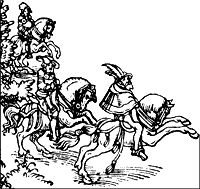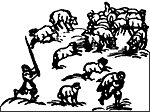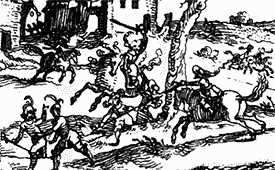 |
Investing for the Siege |

 When
it was time to begin the siege, the defenders had to be surprised in
order they not have any opportunity to rush in additional troops,
ammunition, food stores, etc. To achieve that, attackers could
employ stratagems such as making a feint at another fort or town or
moving the army in such a way as to appear to be marching at a
tangent to the intended target or inocuously lingering some distance
away.
When
it was time to begin the siege, the defenders had to be surprised in
order they not have any opportunity to rush in additional troops,
ammunition, food stores, etc. To achieve that, attackers could
employ stratagems such as making a feint at another fort or town or
moving the army in such a way as to appear to be marching at a
tangent to the intended target or inocuously lingering some distance
away.
Then the attackers swept in quickly and thoroughly to surround the fort - to invest it.
Should defenders express a willingness to stand down and open their gates at this early stage, terms could be generous since besiegers had so far expended little. Incidences of sacking and killing were rare (but not unheard of).
To begin the siege, John Muller's Attac and Defence of Fortified Places made the case for sending in a large contingent, say 4-5,000, of cavalry if the country was open or a combination of horse and foot for wooded and uneven areas, moving as fast as possible. When around four or five miles from the fort, the attacking body divided itself into several parties to continue in along roads, paths and clearings until just out of range of the defenders' cannons and arriving at around dusk. They took positions to stop any relief that may come for the defenders. Next, small parties covered by squadrons of horse slipped in as close as the gates to carry off livestock, portable supplies and men so as to deprive defenders of even these. They struck fast - and hard. Should those in the fort have reacted by firing cannon, then their range and quality of shooting was judged. In addition, other detachments may have been deployed to seize houses, small fortifications or old castles in the general vicinity to deny these to the defense for possible relief and to become bases to harass foragers, attack relief convoys and exact contributions from the populace. Although first published in 1747, Muller's recommendations may well have been guided by what earlier besiegers did; unfortunately, usual references for earlier sieges simply imply the place was surrounded.
 From the perspective of the besieged,
Robert Monro, in his Monro, His
Expedition with the Worthy Scots Regiment Called Mac-Keys, attested to the
speed and fury of the onset of a siege: "...we were
passing the time by discourse, betwixt ten and eleven a clocke at night, when as
our centry gives fire and calls us to our Armes: at our rising we finde the
enemy approaching above a thousand strong, with a shoute... Ensigne Johnston was
with fifty musketiers, that were forced to retire under ground one after another
at a sorting Port, where some were lost before their entry; they being entred,
then begun our souldiers to make service..."
From the perspective of the besieged,
Robert Monro, in his Monro, His
Expedition with the Worthy Scots Regiment Called Mac-Keys, attested to the
speed and fury of the onset of a siege: "...we were
passing the time by discourse, betwixt ten and eleven a clocke at night, when as
our centry gives fire and calls us to our Armes: at our rising we finde the
enemy approaching above a thousand strong, with a shoute... Ensigne Johnston was
with fifty musketiers, that were forced to retire under ground one after another
at a sorting Port, where some were lost before their entry; they being entred,
then begun our souldiers to make service..."
Once attackers invested the fort, more troops came in to augment the numbers already there and to begin making a firm encirclement. Sieges did not begin with a flourish but instead with stealth, speed and surprise.
| Back |
All Around the Fort |
|
|
|